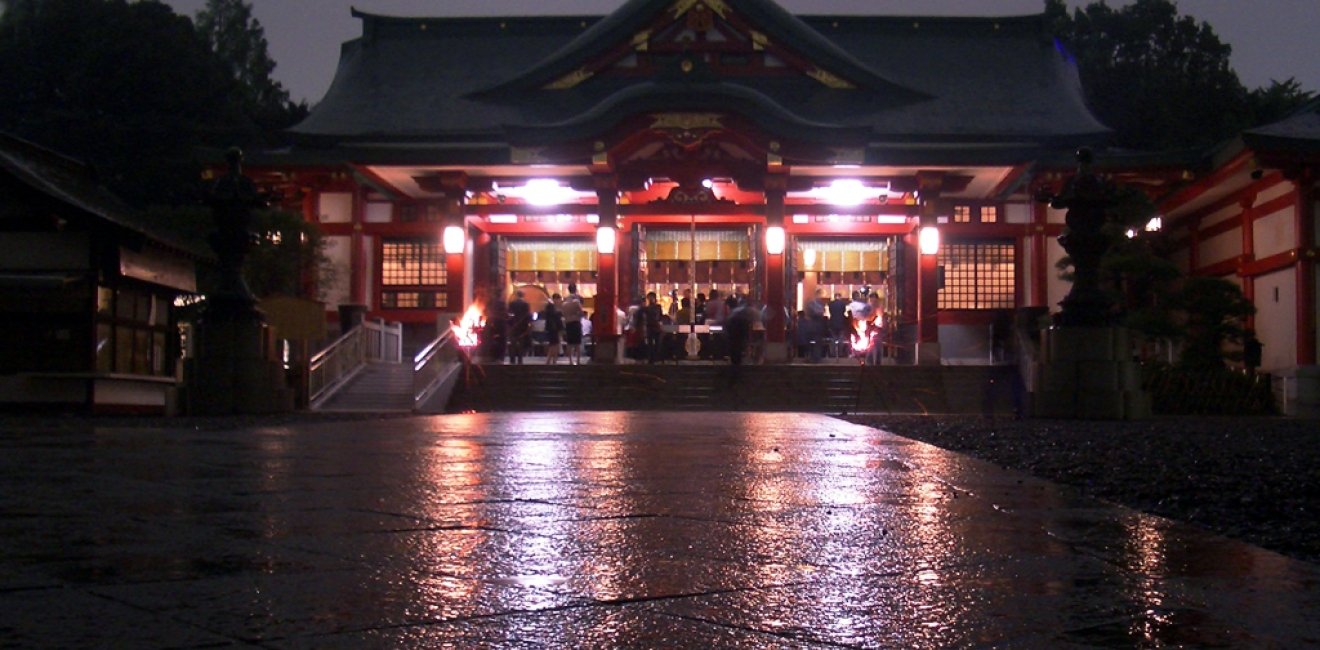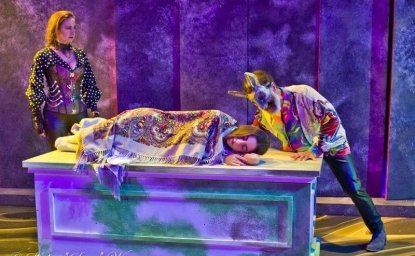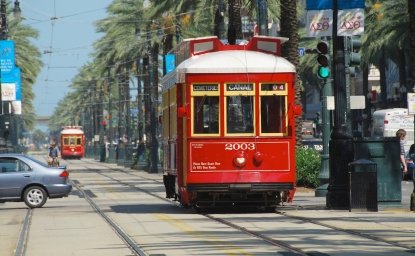
No role can possibly be larger than Godzilla, even if the actor portrays the world’s most famous lizard through motion capture. Kyōgen idol Mansai Nomura must have experienced special pride in playing the rampaging giant in the 2016 film Godzilla: Resurgence, the 29th installment of perhaps the world’s longest cinematic series. Then again, Nomura had already done it all since first appearing on stage in Quiver of the Monkey at the age of three. For nearly a half-century, Nomura has garnered every conceivable Japanese award for stage and screen following his masterful appearance at the age of 17 in a supporting role for Akira Kurosawa’s epic Ran (1985). Furthermore, he has collected kudos worldwide for his adaptations of Shakespeare to Japanese stage traditions. His kyōgen production of Macbeth has enjoyed rave reviews in nearly every major theater city on the planet; and his transformation of Richard III into A Country Thief won munificent praise at home.
Mansai Nomura is but the latest noteworthy in a family line of prominent actors reaching back more than two centuries. His father Mansaku--a Living National Treasure of Japan--has been praised for proselytizing Japanese theatrical traditions around the world ever since his rousing initial appearance at the Paris International Theater Festival in 1957. Mansaku’s father Manzo, in turn, was also declared to be a Living National Treasure as he came to personify the traditions of the distinctive Izumi School of kyōgen (in contrast to those of the Sagi and Ōkura traditions).
Despite his prestigious dramaturgical pedigree, Mansai Nomura did not decide to become an actor until he was in his late teens. His talents simply could not be contained by any single tradition. In addition to his impeccable kyōgen credentials, he studied at the Royal Shakespeare Company in London, has lectured in aesthetics at the prestigious Tokyo University, and has won the hearts of tens of thousands of television and film fans. Yet, it is to kyōgen that he always returns.
Often compared to Italian Commedia dell’arte, kyōgen is among one of the oldest of all theatrical traditions. Originating as a comedic counterpart to Noh drama at the dawn of the 14th century, kyōgen began as an improvisational art drawing humor from the everyday. Centuries later, kyōgen still is known for its straight-forward storytelling and expressive, clear speech. These characteristics made its repertoire of around two-hundred or so plays readily adaptable to television and film so that kyōgen remains hugely popular in contemporary Japan.
Despite its age, kyōgen remains very much a living art form. Older performers pass the drama’s spirit as well as its technique to younger performers while its improvisational origins encourage contemporary performers to hold up their classical mirror to modern life. By doing so, they sustain tradition through distinct costumes, delivery and especially language which ties a performance’s slapstick and satire back to century-old traditions. The result is a fusion that constantly reinvigorates the classical with the modern.
Nomura’s time in London expanded his vision for this dramatic practice of kyōgen. More specifically, he has acknowledged, he found that British actors trained in Shakespearean conventions learned how to use their body and physicality to express emotions relating to the contemporary world, thereby opening the door to radical reinterpretations of old works. Understanding kyōgen as the most emotionally accessible of all historic Japanese art forms, Nomura imagined a pathway to align a centuries-old art form with modern life. Similarly, he fixed on the centrality of gender relations to the kyōgen storytelling as an entry point into emphasizing universality across time and space.
Nomura was not alone in his desire to connect kyōgen to contemporary theater. Kazuhiro Morisaka, for example, has encouraged young performers to embrace a variety of performance styles while simultaneously striving to expand the existing repertoire with new works. Nomura similarly has trained and mentored young performers; and, he has expanded audiences using his own star power to multiply the community of kyōgen fans.
Nomura’s celebrated father and grandfather are unlikely to have played Godzilla (and probably never would have been invited to do so). Mansai, however, has cultivated an enthusiastic fan base in contemporary theater, as well as in film and on television. His popularity reaches across generations as he has used appearances on the popular children’s television show Let’s Play in Japanese to introduce ever younger viewers to kyōgen. He has staged the centuries-old kyōgen play Sambaso to the backdrop of Maurice Ravel’s Boléro, emphasizing similarities in the underlying structures of both works. At the same time, he has argued that greater accessibility should not be allowed to deplete aesthetic standards. Rather, he seeks to reinvigorate Japanese culture by bringing traditions into the present.
Most recently these various efforts have converged at the Setagaya Public Theatre where Nomura has been artistic director since 2002. The theater opened its doors in 1997 in a non-descript commercial complex in one of Tokyo’s outer boroughs. Setagaya is one among two-dozen administrative wards that make up the city and would not seem very “suburban” to most Americans. Home to around 900,000 residents, it is the largest among Tokyo’s wards in population and second largest in the amount of territory it occupies. Setagaya’s population density is about twice that of New York City.
Founded at the initiative of the ward administration, Setagaya Public Theatre’s mission has been to keep a living culture central to local life. The theatre has provided a welcomed home to large numbers of visual artists and writers; the ward in turn created an autonomous literary museum to celebrate its own cultural successes. The theater’s artistic team promotes jazz, modern dance and contemporary theater to local audiences. Outreach programs extend to the disabled and infirmed, to children and the elderly, and the merely interested. Each year, the staff and producers create a play based on the stories told by local residents.
Nomura has insured that, at some point during their school career, each of the ward’s 6,000 schoolchildren attends one of the theater’s kyōgen performances. Somewhere around a third of ward residents have attended a performance of some kind at the theater, while the theater estimates that between 80 and 90 percent of its audience arrives from outside the ward, including from abroad.
Mansai Nomura is custodian of a centuries-old theatrical tradition that has been associated with his own family for too many generations to recall. He has dedicated his career to reinvigorating that tradition, linking it to the contemporary world without weakening its own distinctiveness. To do so, he has enlisted thousands of fans in a community of shared intention, including Japan’s most well-known radioactive lizard behemoth. Indeed, he has made the path from medieval Zen monk to Godzilla, from television idol to Macbeth, appear remarkably effortless.
Artistic Visionaries and Community Creators
The power of the performing arts to nurture inclusive communities has been praised widely in recent years; so much so that “creative placemaking” is now seen as a powerful tool in community development. The supportive role of community in fostering artistic innovation is less acknowledged. This series highlights the work of visionaries for whom creating communities of students, protégés, audiences, and donors has become a strategic element in transforming their arts.
Author

Former Wilson Center Vice President for Programs (2014-2017); Director of the Comparative Urban Studies Program/Urban Sustainability Laboratory (1992-2017); Director of the Kennan Institute for Advanced Russian Studies (1989-2012) and Director of the Program on Global Sustainability and Resilience (2012-2014)
Explore More in Artistic Visionaries and Community Creators
Browse Artistic Visionaries and Community Creators
Mark and Susan Marie Rhea and Irish Theater

Hugo and Rebecca Medrano and Hispanic Theater

Andrew Kingsley, Andrew Vaught and Social Impact Theater

